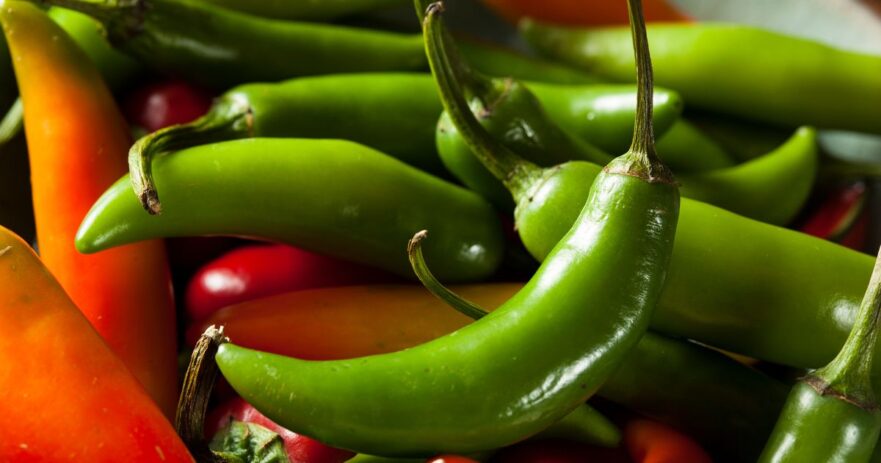In this article about serrano pepper:
🗺️ Origin and history | 🌶️ Uses | ✨ Appearance and taste | 🌶️ Types | 🧑🌾 Growing – gardening | 👨🍳 Cooking – recipes | 🛒 Where to buy | 🫙 How to store | 👨⚕️ Health benefits | 🌶️ Alternatives and substitutes | ❓ Frequently asked questions
What is Serrano pepper?
Serrano peppers are chili, with a medium to hot kick of spice, originally found in Mexico’s mountainous regions. Small and slender, they typically measure between 1 to 4 inches total in length, ranging from green to red or even yellow in color when fully ripe. Serranos are often available for purchase fresh, dried, or pickled in grocery stores.
The heat level of serrano peppers varies from 10,000 to 23,000 Scoville heat units. These peppers are often incorporated into many dishes, including salsas, sauces, and salads, where they add a nice kick and distinct flavor. Particularly popular in Mexican cuisine, they are often used to enhance tacos, fajitas, and other traditional dishes to a greater taste.
| Serrano pepper | |
| SHU | 10,000 - 23,000 |
| Median SHU | 16,500 |
| Flavor | Crisp, bright, vegetable and notably hot |
| Species | Capsicum annuum |
| Origin | Mexico |
| Uses | Salsas, sauces, pico de gallo, pickling, giardiniera, etc. |
Are Serrano peppers spicy? How hot are they?
Serrano pepper Scoville: 10,000 to 23,000 SHU
On the Scoville scale, serrano peppers are considered moderately hot. With a rating that spans from 10,000 to 23,000 Scoville units, they are spicier than many popular peppers, such as jalapeños (which fall between 2,500 and 8,000 Scoville units).
There are several alternatives if you want a spicier option than serrano peppers. For example, bird’s eye chilies (Thai chilies) and cayenne peppers offer a more intense level of heat while habanero peppers give off a fierier taste. Conversely, if you desire to use a milder pepper, a couple of options include banana peppers (ranging from 0 to 500 Scoville units) or pepperoncini peppers.
Ultimately, serrano peppers‘ heat level is most enjoyed by those who love solid spiciness in their meals but do not want extreme heat. With a unique flavor profile, serrano peppers are an excellent choice for individuals who want to add a nice flavor and medium spice level to their culinary dishes.
🗺️ ORIGIN AND HISTORY
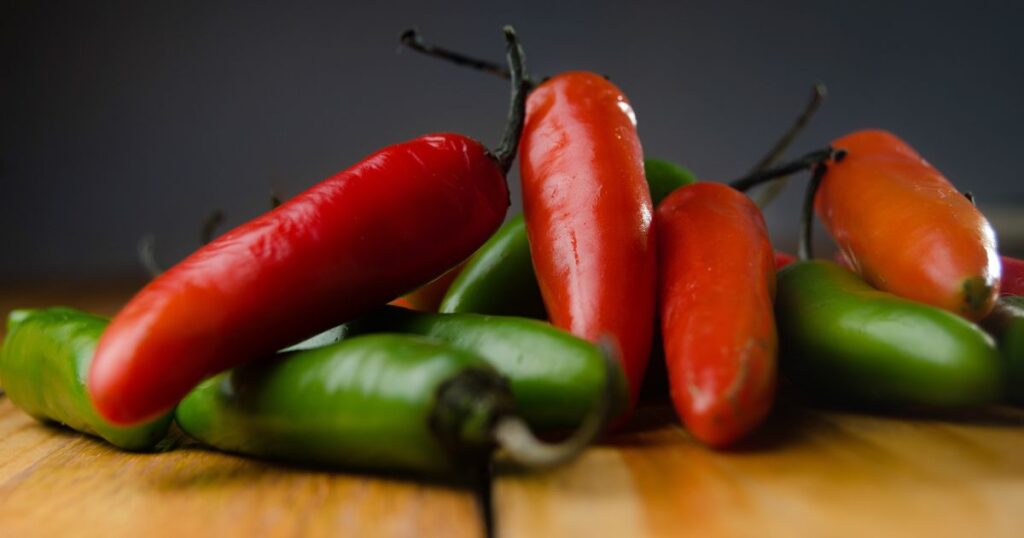
Where do serrano peppers come from?
Serrano peppers were originally located in Mexico’s mountain regions, primarily in the states of Puebla and Hidalgo. The name “serrano” is derived from the Spanish word for mountain, a constant reminder of the pepper’s ideal high-altitude environment for ideal growth. The peppers are widely used in traditional Mexican cuisine and are integral to Mexico’s heritage.
Over time, serrano peppers were introduced to various parts of the world, rising in popularity due to their unique flavor and moderate heat level. In the United States, serrano peppers are featured regularly in Mexican-American foods, adding a spicy kick to salsas, sauces, and many more meals.
🌶️ USES
What are Serrano peppers good for? How to use them?
Because of their distinct flavor and heat level, serrano peppers are utilized in a variety of cuisines and recipes. Their versatility enhances many dishes, ranging from traditional Mexican cuisine to contemporary fusion dishes.
Pickled serrano peppers are popular when tang and spice are both needed in a meal. They will become a favorite when added to sandwiches, tacos, or as a garnish in salads. The pickling process also helps preserve the peppers for an extended shelf-life as they are ready to eat year-round.
Another way to enjoy serranos is when they are dried. Dried serrano peppers can be ground into a powder or rehydrated to use in sauces, soups, and stews. During the drying process, their flavor is deepened, giving them an earthy, rich taste in the meals it is added to.
Smoking serrano peppers yields wonderful results to gain a richer, smokier taste. The smoked peppers are often added to salsas, marinades, or spice rubs for meats, such as pork and chicken. Their smokiness adds an extra kick and layer of flavor to your dishes.
Serrano pepper salsa is a classic creation that utilizes these spicy chilies. If you combine serrano peppers with tomatoes, onions, garlic, and cilantro, you will create a fresh, savory salsa perfect for eating plain with tortilla chips or using as a topping for your favorite Mexican dishes. The heat level can be increased or decreased by altering the amount of serranos you use, according to your preferences.
✨ APPEARANCE AND TASTE
What do serrano peppers look like?
Serrano peppers are on the small side, about 1 to 4 inches in length, and typically half an inch to one inch in diameter. Like many peppers, their shape is elongated and slightly tapered on the end. With a smooth texture, they begin their maturation process with a bright green color, transitioning to red, orange, or yellow when fully ripe. However, they are often harvested and eaten while still green before reaching maturity.
What do serrano peppers taste like?
Serrano peppers offer a crisp, rich flavor with moderate heat. They offer more spiciness than jalapeños, so they are popular with those wanting more heat in their meals. In addition, when cooked or pickled, they sometimes gain a smoky or tangy taste, further enhancing their flavor.
🌶️ TYPES
What are the different types of serrano peppers?
During the ripening process, serrano peppers go through a range of colors and flavors. This section will discuss the four varieties: green, red, purple, and yellow.
Most commonly used, green serrano peppers are typically harvested while still unripe. At this stage, they offer a crisp flavor with moderate heat. Green serranos are often put in salsas and sauces, providing a fresh, earthy taste.
Red serrano peppers are fully ripe with a slightly sweeter flavor profile than green ones. While serranos‘ heat level remains the same as the green variety, or possibly slightly higher, their stark red color and richer taste may give them a certain visual and flavorful appeal when added to various cuisines.
Purple serrano peppers are far less common. Their flavor is similar to green and red serrano peppers, but the heat level is usually milder. Purple serranos are used interchangeably with other serranos, and most notably, they add a unique color to any dish.
Finally, yellow serrano peppers are another lesser-used variety, though they are cheerful yellow. Also an excellent choice for salsas, marinades, or any dish that would benefit from a beautiful color addition.
🧑🌾 GROWING – GARDENING
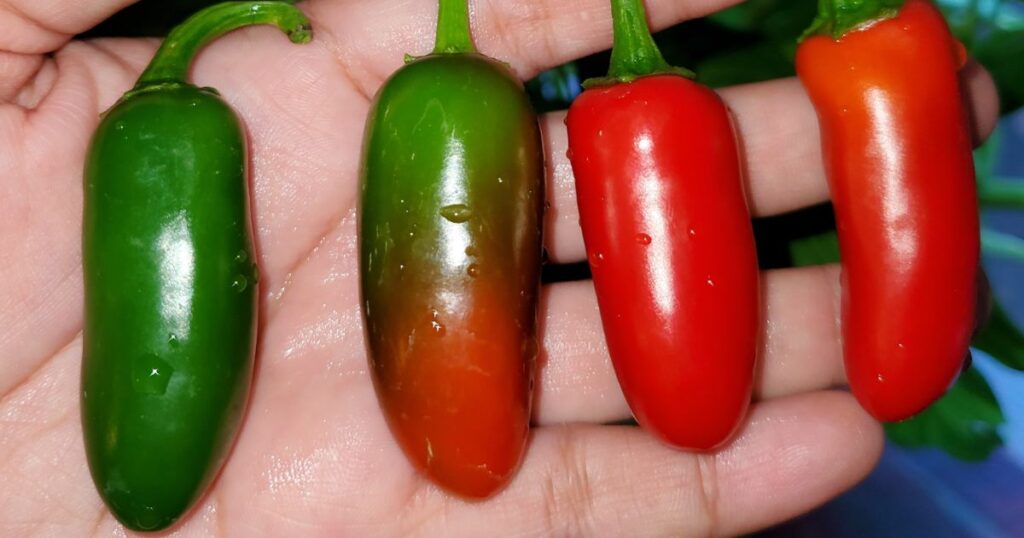
How to grow serrano peppers?
Easy to grow, serrano peppers are a popular choice for home gardeners. These peppers prefer warmer climates with abundant sunlight, though they can still grow in many conditions. Planting them in soil that drains well and watering them adequately will ensure they grow properly. Regular fertilization, particularly during the growing season, will help yield a healthy and bountiful harvest. For continuous growth, it is encouraged to harvest mature serranos consistently.
When to pick serrano peppers?
Whether grown in the ground or in containers, serrano peppers reach maturity after between 75 to 85 days on average. The peppers can be picked during various stages of ripeness, depending on your preference for color and flavor as discussed above.
👨🍳 COOKING – RECIPES
Cooking and recipe ideas for serrano peppers
Serrano peppers bring a unique element to a variety of dishes, enhancing them with dynamic flavors and moderate heat level. A great addition to many recipes, roasted serrano peppers are used in salsas or as a taco topping. To roast them, place the peppers on a baking sheet and cook them in the oven at a high temperature until their skin is visually slightly charred, then peel and chop as desired once cooled off.
Grilled serrano peppers are an excellent appetizer or side dish during the summer. Put the peppers on skewers and grill them over a medium-high heat until tender and slightly charred, then serve alongside grilled meats or vegetables to add a bit of spice.
For an addition to a classic hamburger, you can cook serrano burgers, incorporating the heat of these peppers into the patty mixture. Just mix minced serrano peppers with your ground beef or turkey, along with your normal seasonings, then grill or pan-fry the patties, serving them on buns with your regular toppings.
Extremely popular when added to soups, serranos will add a touch of heat to complement other ingredients used in your favorite types. Finely dice the peppers and put them into your favorite soup, such as a classic chicken noodle soup or a hearty chili. The broth will grab onto the peppers‘ flavor, providing their signature heat and taste to create a warm and delicious meal.
Lastly, salsas that incorporate serrano peppers are ideal for dipping with chips, tacos, or enchiladas. Combine chopped serrano peppers with tomatoes, onions, cilantro, lime juice, and salt to result in a simple yet flavorful, homemade salsa. With moderate heat to balance the fresh, tangy flavors in the salsa, it will become a go-to side dish.
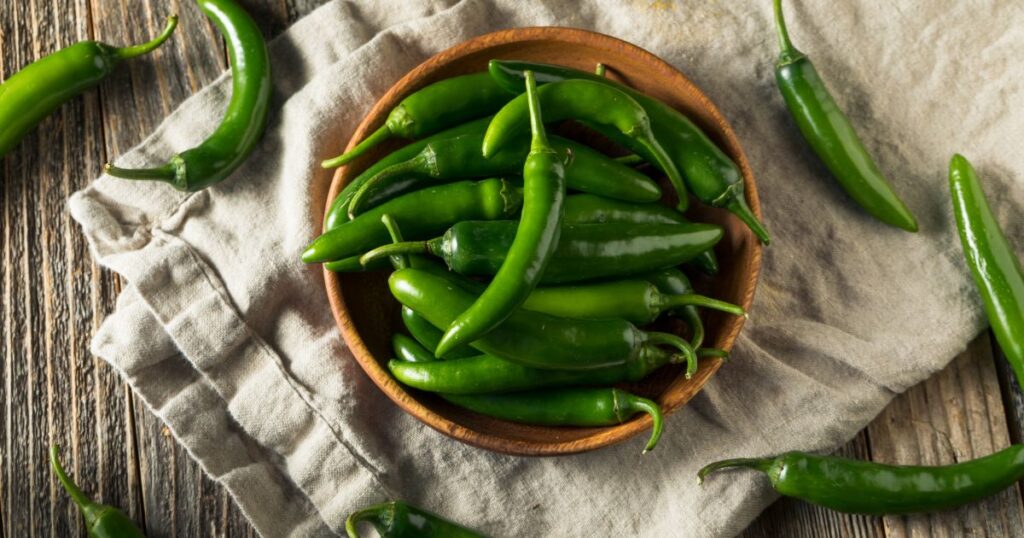
🛒 WHERE TO BUY
Where can I buy serrano pepper?
The good news is that serrano peppers are available fresh in most grocery stores and markets in the produce section. When you are in the store, look for the pepper section as they will be sold alongside other fresh peppers, including bell peppers and jalapeños. If they are not with the other peppers, check the area around the tomatoes and onions as they may be kept nearby.
Sometimes serrano peppers are not available in local grocery stores. If this is the case, you can visit a specialty store catering to Latin American and Mexican food offerings. Those stores will likely carry a wider range of peppers, including serranos.
Online retailers also often sell serrano peppers in various forms, including fresh, dried, or pickled. When you cannot find them at a local store, purchasing online may be the most convenient choice.
Local gardeners may sell their fresh serrano peppers at local farmer’s markets, so be sure to check for this fresh produce when these are held throughout the summer months. You will also have the opportunity to support local farmers and possibly find different varieties of serranos.
Where can I buy serrano pepper plants?
If you are interested in growing your serrano peppers, you will need to find the plants to grow them. These are usually found at local garden centers or nurseries. When selecting serrano pepper plants, only buy healthy ones with a nice solid green color and sturdy stems. Avoid any plants that appear wilted, unhealthy, or have yellow leaves. These are signals of an unhealthy plant.
Where can I buy serrano pepper seeds?
Sometimes home gardeners prefer to begin from seeds and grow serrano peppers that way. Most garden centers will offer serrano seeds, otherwise, you can locate them online. For best success, just follow the instructions provided on the seed packet and plant the seeds where they’ll receive plenty of sunshine and have good soil.
🫙 HOW TO STORE
How do I store serrano peppers?
Fresh serrano peppers can be stored in the refrigerator for up to two weeks before they begin to lose their freshness. For proper storage, put the pepper in a plastic bag or airtight container to preserve its freshness, then set it in the crisper drawer. This will also help prevent them from drying out.
Pickled serrano peppers can last in the refrigerator for several months, typically indicated by an expiration date on the jar. For pickled peppers storage, leave them in the original jar or transfer them to your preferred airtight container, then put them in the fridge. Keeping them there will keep them flavorful with the right texture.
Can serrano pepper be frozen?
Serrano peppers are often frozen to extend their use. Follow these easy steps to freeze them. Wash the peppers thoroughly and then remove their stems and seeds. Next, lay them on a baking sheet in a single layer, placing them in the freezer for a few hours until fully frozen. Finally, move them into an airtight container or a plastic freezer bag, then keep them in the freezer for up to six months. Once you’re ready to use them again, just pull them out to thaw and add them to your favorite recipes!
❤️🩹 HEALTH BENEFITS
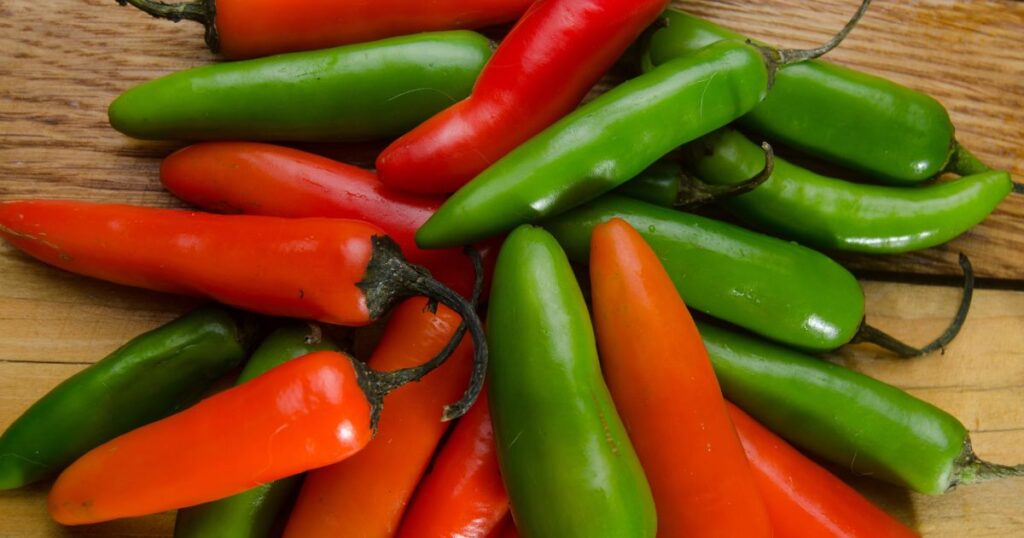
Are serrano peppers healthy for you?
Serrano peppers provide several health benefits in addition to their yummy flavor. Low in calories and rich in fiber, they are a great source of vitamin C and vitamin A, supporting healthy immune systems and good eye and skin health. Overall, these are a great pepper to include in your diet.
Capsaicin primarily gives serrano peppers their spiciness and has been linked to many health benefits. There is a correlation between capsaicin and anti-inflammatory and pain-relieving properties. Other studies have tracked capsaicin’s ability to improve metabolism and assist in weight loss, though further research should be conducted to draw those conclusions fully.
Some people experience stomach upset or other reactions when consuming spicy foods, including serrano peppers. If this is the case for you, we advise you to avoid eating them or reduce the amount of them you eat.
🔄 ALTERNATIVES AND SUBSTITUTES
What’s a good alternative for serrano pepper?
Several options exist for a nice alternative to serrano peppers if you seek a similar heat and flavor. Among the most popular substitutes are jalapeño peppers with milder heat and similar flavor. Easily utilized in place of serrano peppers, they will fit into almost any recipe that calls for serranos, such as salsas, sauces, and chilies.
Another comparable option is the Thai bird’s eye chili, though it has a higher heat level than serranos. Especially popular in Asian cuisine, this chili is a great substitute in dishes that call for intense heat. However, due to the increase in heat level, take caution when using the Thai bird’s eye chilies as they may overpower other ingredients and pose an issue for those sensitive to spiciness.
On the other end of the spectrum are poblano peppers. Although bigger and less spicy than serranos, they share a similar flavor and are also easily substituted into sauces that would call for a serrano pepper. They are also enjoyed as stuffed peppers.
For a powdered serrano pepper substitute, cayenne peppers are popular. They offer a hotter flavor and are widely available in powdered form, making them a great addition to recipes that need a little kick.
How do you pronounce serrano pepper?
Serrano pepper is pronounced seh-RAH-noh peh-per.
🙋 FREQUENTLY ASKED QUESTIONS
FAQ about serrano peppers
Are serrano peppers hot?
Yes, serrano peppers are considered hot, ranging from medium to hot heat levels. They rank between 10,000 and 23,000 on the Scoville Heat Unit scale. They fall between jalapeño peppers and habaneros on the scale, hotter than jalapeños but milder than habaneros. Because the spiciness of each pepper varies, it’s important to taste each one before adding it to your dish.
Can serrano peppers burn your skin?
As referenced earlier, serrano peppers contain capsaicin, the compound responsible for their heat. When handling serrano peppers, it is possible for capsaicin to irritate the skin or give a burning sensation to some individuals, especially those with sensitive skin. We recommend you wear gloves when handling serranos to prevent skin irritation or to wash your hands thoroughly after working with them if you opt not to wear gloves.
Do serrano peppers taste like jalapeños?
While serrano and jalapeño peppers taste similar in flavor, serranos are typically hotter with a prolonged and pronounced heat. Serrano peppers‘ skin is thinner than jalapeños for a different texture when cooked or eaten independently.
What are the benefits of eating serrano peppers?
Several health benefits come from consuming serrano peppers, including support for a healthy immune system, eyes, and skin. They are low in calories and high in vitamins A and C. The capsaicin found in serranos also assists with anti-inflammatory properties and can contribute to pain relief. Some studies suggest that capsaicin may boost metabolism and aid in weight loss, though more research is needed.
What are the differences between serrano and jalapeño peppers?
The primary difference between serrano and jalapeño peppers is related to their heat levels and sizes. Generally smaller and thinner than jalapeños, serranos also give more of a spicy kick. They also have a slightly fruitier flavor and their thin skin has a noticeable difference in texture than jalapeños.
What should I do if I get serrano pepper in my eye?
If a serrano pepper comes into contact with your eye, it may cause intense burning and irritation due to the capsaicin inside. First, your instincts will tell you to rub your eyes, but avoid doing this as it will worsen the irritation. Instead, flush out your eye with cool water for 10-15 minutes, allowing the water to dilute and remove the capsaicin. If irritation persists or worsens, seek medical attention promptly at your local emergency room.
